ASSOCIATIVE PROPERTY OF SET WORKSHEET
Subscribe to our ▶️ YouTube channel 🔴 for the latest videos, updates, and tips.
Question 1 :
Given, A = {1, 2, 3, 4, 5}, B = {3, 4, 5, 6} and C = {5, 6, 7, 8}.
Show that
A u (B u C) = (A u B) u C
Also, verify the above using Venn diagram.
Question 2 :
Given A = {a, b, c, d}, B = {a, c, e} and C = {a, e}.
Show that
A n (B n C) = (A n B) n C
Also, verify the above using Venn diagram.
Question 3 :
Verify A u (B u C) = (A u B) u C for the following three sets A, B and C.
A = {x : x is a prime factor of 42}
B = {x | 5 < x ≤ 12, x ∊ N}
C = {1, 4, 5, 6}
Question 4 :
U = {x | 0 < x < 10, x ∈ N}
A = {x | x is a prime number less than 10}
B = {x| x is even number less than 10}
C = {x|x is an odd natural number less than 10}
i) Represent sets U, A, B and C on Venn diagram.
ii) List the elements of A n C
iii) List the elements of A n B.
iv) Show that (A U B U C) = U
Question 5 :
U = {1, 2, 3, 4, 5, 6, 7, 8}
A = {1, 2, 3, 4}
B = {3, 4, 5, 8}
C = {1, 3, 5, 7}
a) Represent these sets in Venn diagram.
b) Show that (A U B) U C = A U (B U C)
c) Show that (A n B) n C = A n (B n C)
d) Show that (A\B)\C ≠ A \ (B\C)

1. Answer :
Given, A = {1, 2, 3, 4, 5}, B = {3, 4, 5, 6} and C = {5, 6, 7, 8}.
BuC = {3, 4, 5, 6} u {5, 6, 7, 8}
Buc = {3, 4, 5, 6, 7, 8}
Au(BuC) = {1, 2, 3, 4, 5} u { 3, 4, 5, 6, 7, 8}
Au(BuC) = {1, 2, 3, 4, 5, 6, 7, 8} ----(1)
AuB = {1, 2, 3, 4, 5} u {3, 4, 5, 6}
AuB = {1, 2, 3, 4, 5, 6}
(AuB)uC = {1, 2, 3, 4, 5, 6} u {5, 6, 7, 8}
= {1, 2, 3, 4, 5, 6, 7, 8} ----(2)
From (1) and (2),
Au(BuC) = (AuB)uC
Venn Diagram :
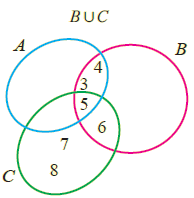 |
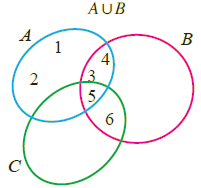 |
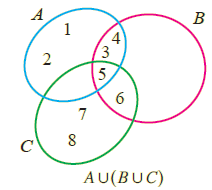 |
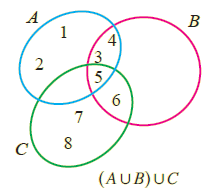 |
2. Answer :
Given A = {a, b, c, d}, B = {a, c, e} and C = {a, e}.
BnC = {a, c, e} n {a, e}
BnC = {a, e}
An(BnC) = {a, b, c ,d} n {a, e}
An(BnC) = {a} ----(1)
AnB = {a, b, c, d} n {a, c, e}
AnB = {a, c}
(AnB)nC = {a, c} n {a,e}
(AnB)nC = {a} ----(2)
From (1) and (2),
An(BnC) = (AnB)nC
Venn Diagram :
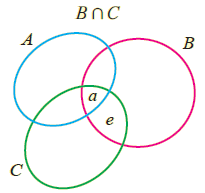 |
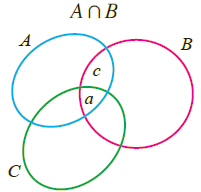 |
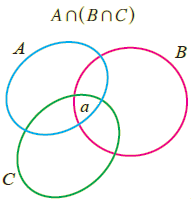 |
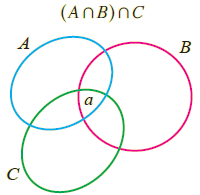 |
3. Answer :
A = {x : x is a prime factor of 42} ---> A = {2, 3, 7}
B = {x | 5 < x ≤ 12, x ∊ N} ----> B = {6, 7, 8, 9, 10, 11, 12}
C = {1, 4, 5, 6}
BuC = {6, 7, 8, 9, 10, 11, 12} u {1, 4, 5, 6}
BuC = {1, 4, 5, 6, 7, 8, 9, 10, 11, 12}
Au(BuC) = {2, 3, 7} u {1, 4, 5, 6, 7, 8, 9, 10, 11, 12}
Au(BuC) = {1, 2, 3, 4, 5, 6, 7, 8, 9, 10, 11, 12} ----(1)
AuB = {2, 3, 7} u {5, 6, 7, 8, 9, 10, 11, 12}
AuB = {2, 3, 5, 6, 7, 8, 9, 10, 11, 12}
(AuB)uC = {2, 3, 5, 6, 7, 8, 9, 10, 11, 12} u {1, 4, 5, 6}
(AuB)uC = {1, 2, 3, 4, 5, 6, 7, 8, 9, 10, 11, 12} ----(2)
From (1) and (2),
Au(BuC) = (AuB)uC
4. Answer :
U = {x | 0 < x < 10, x ∈ N}
U = {1, 2, 3, 4, 5, 6, 7, 8, 9}
A = {2, 3, 5, 7}
B = {2, 4, 6, 8}
C = {1, 3, 5, 7, 9}
i) Represent sets U, A, B and C on Venn diagram.
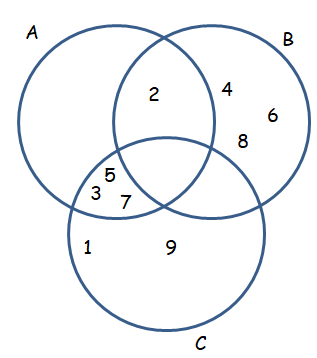
ii) A n C
= {2, 3, 5, 7} n {1, 3, 5, 7, 9}
A n C = {3, 5, 7}
iii) List the elements of A n B.
= {2, 3, 5, 7} n {2, 4, 6, 8}
A n B = {2}
iv) Show that (A U B U C) = U
(A U B U C) = {2, 3, 5, 7} U {2, 4, 6, 8} U {1, 3, 5, 7, 9}
= {1, 2, 3, 4, 5, 6, 7, 8, 9}
= The universal set.
Hence it is proved.
5. Answer :
U = {1, 2, 3, 4, 5, 6, 7, 8}
A = {1, 2, 3, 4}
B = {3, 4, 5, 8}
C = {1, 3, 5, 7}
a) Represent these sets in Venn diagram.
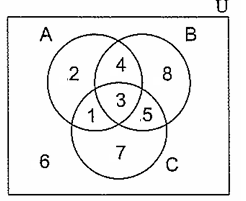
b) (A U B) U C = A U (B U C)
(A U B) = {1, 2, 3, 4} U {3, 4, 5, 8}
= {1, 2, 3, 4, 5, 8}
(A U B) U C = {1, 2, 3, 4, 5, 8} U {1, 3, 5, 7}
= {1, 2, 3, 4, 5, 7, 8} -----(1)
(B U C) = {3, 4, 5, 8} U {1, 3, 5, 7}
= {3, 4, 5, 7, 8}
A U (B U C) = {1, 2, 3, 4} U {3, 4, 5, 7, 8}
= {1, 2, 3, 4, 5, 7, 8}-----(2)
c) (A n B) n C = A n (B n C)
A n B = {1, 2, 3, 4} n {3, 4, 5, 8}
= {3, 4}
(A n B) n C = {3, 4} n {1, 3, 5, 7}
= {3} ------(1)
(B n C) = {3, 4, 5, 8} n {1, 3, 5, 7}
= {3, 5}
A n (B n C) = {1, 2, 3, 4} n {3, 5}
= {3} ------(2)
d) (A\B)\C ≠ A \ (B\C)
A =
B = {3, 4, 5, 8}
C = {1, 3, 5, 7}
A\B = {1, 2, 3, 4}\{3, 4, 5, 8}
= {1, 2}
(A\B)\C = {1, 2}\{1, 3, 5, 7}
= {2} -----(1)
B\C = {3, 4, 5, 8}\ {1, 3, 5, 7}
= {4, 8}
A\(B\C) = {1, 2, 3, 4}\{4, 8}
= {1, 2, 3} -----(2)
(1) and (2) are not equal.
Subscribe to our ▶️ YouTube channel 🔴 for the latest videos, updates, and tips.
Kindly mail your feedback to v4formath@gmail.com
We always appreciate your feedback.
About Us | Contact Us | Privacy Policy
©All rights reserved. onlinemath4all.com

Recent Articles
-
US Common Core K-12 Curricum Algebra Solving Simple Equations
Jan 07, 26 01:53 PM
US Common Core K-12 Curricum Algebra Solving Simple Equations -
10 Hard SAT Math Questions (Part - 4)
Jan 05, 26 06:56 PM
10 Hard SAT Math Questions (Part - 4) -
10 Hard SAT Math Questions (Part - 3)
Jan 05, 26 06:34 PM
10 Hard SAT Math Questions (Part - 3)

